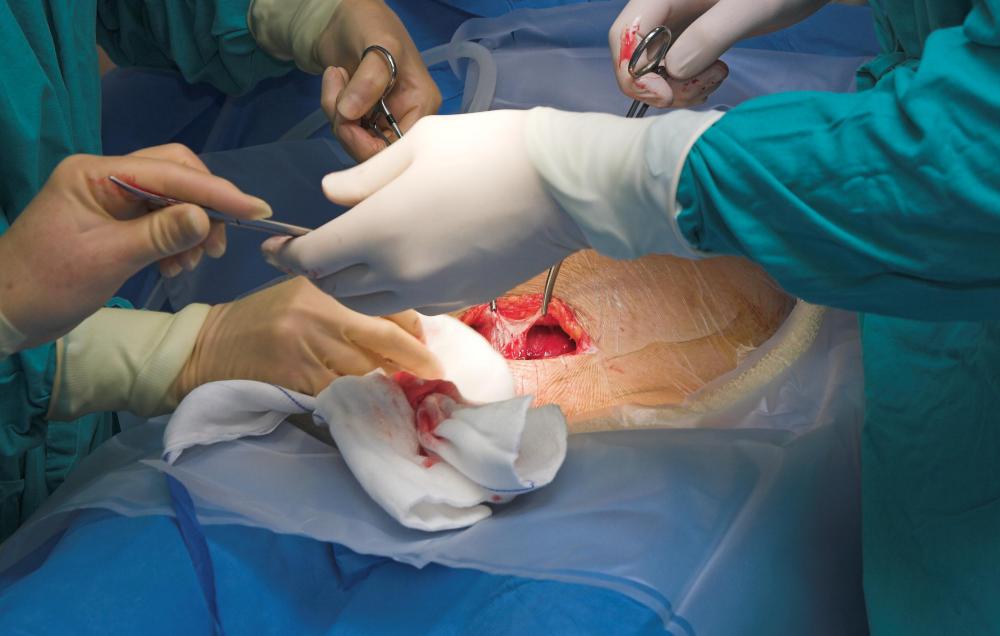At WiseGEEK, we're committed to delivering accurate, trustworthy information. Our expert-authored content is rigorously fact-checked and sourced from credible authorities. Discover how we uphold the highest standards in providing you with reliable knowledge.
What Are the Most Common Childbirth Problems?
It is important for pregnant women and their partners to educate themselves about common childbirth problems so they will be better prepared if they experience a complication during labor or delivery. Some childbirth problems can be anticipated before the woman goes into labor, while others arise spontaneously during the process. The most common childbirth problems include preterm labor, fetal distress, abnormal fetal positioning, shoulder dystocia, and umbilical cord problems. Other problems are possible, and pregnant women should speak to their doctors about any questions or concerns unique they may have.
Preterm labor is a common childbirth problem. Infants born before the mother has reached 34 weeks gestation are usually not fully developed and may suffer from heart problems, breathing difficulties, and other major concerns. Doctors may administer medications to postpone labor for short periods. Steroids are often given to women who go into labor before 34 weeks if the labor cannot be stopped. This helps quickly develop the baby's lungs and other vital organs, reducing the risk of serious complications after the birth.

Fetal distress is usually identified by abnormal changes in the baby's heart rate during delivery. Women who deliver after their due dates or experience other childbirth problems during labor have a greater risk of having their babies go into fetal distress. Doctors treat each case of distress depending on the severity of the condition. Sometimes giving the mother oxygen or additional fluids is sufficient. In other cases, doctors may need to use forceps to help the mother deliver the baby as quickly as possible or perform a Cesarean section, a surgical procedure to remove the baby from the mother's womb.

Abnormal fetal positioning can also create childbirth problems. Normally, the baby should be facing head down toward the mother's back with its chin tucked in toward its chest. Babies who face forward, legs down, or position themselves with their shoulders facing the birth canal often have difficulty passing through the birth canal, and the woman may not be able to deliver vaginally. Doctors often use forceps or vacuum extractors to help women with babies in abnormal positions, though a Cesarean section is sometimes necessary.

Shoulder dystocia happens when one of the baby's shoulders gets caught on the mother's hipbone, preventing the baby from sliding the rest of the way through the birth canal. This can be dangerous since the baby often cannot breathe in this position. Doctors try different maneuvers to quickly help the baby free its shoulder so the mother can push the infant the rest of the way out. If these techniques do not work within a few minutes, doctors usually help push the baby's head back inside the mother and preform an emergency Cesarean section.

The most common umbilical cord problems that may occur during childbirth are a prolapsed umbilical cord and a nuchal cord. A prolapsed cord comes out of the birth canal before the baby, which can cut off the blood and oxygen supply to the infant. When this happens, doctors must perform an immediate Cesarean section to deliver the baby.
A nuchal cord occurs when the umbilical cord wraps around the baby's neck. This does not often cause serious complications and can be slipped off the baby during delivery. In other cases, the doctor must cut the cord once the baby's head is outside the vagina.
AS FEATURED ON:
AS FEATURED ON:
















Discussion Comments
@irontoenail - I actually find it interesting that humans managed to get to the point where we can have so many pregnancy problems and concerns. Other mammals probably don't even realize they are pregnant and give birth without a qualm because their heads aren't nearly as developed as ours. We basically evolved to the point where we need assistance to be born.
@pleonasm - A lot of the problems those poor women faced were actually caused by the doctors that were supposed to help them. Modern medicine is a wonderful thing, but we've gone through a few ugly stages before getting to this point.
A woman thousands of years ago would have been healthy and fit and would have been tended by healers who had delivered dozens of other babies. She would have squatted rather than lying down (which is a position hospitals prefer because it's easier for the doctor, not for the mother and infant) and gravity would have assisted her.
I'm not saying there were never childbirth problems, or even deaths back then, but it wasn't a complete nightmare either.
I just don't know how children ever got born back in the days before we had all this advanced medicine to help them. I visited an old operating theater in London a few years ago which had been turned into a museum and the tour guide basically told us that mothers back then would simply not survive a Cesarean. When an operation that big is performed without anesthetic, more often than not they would simply die of shock and take the baby with them for anyone could save it.
Of course, if either of them did survive, there were all kinds of problems with infection and so forth. It's a wonder the human race survived to this point. It definitely convinced me I'd never want to give birth outside a hospital.
Post your comments